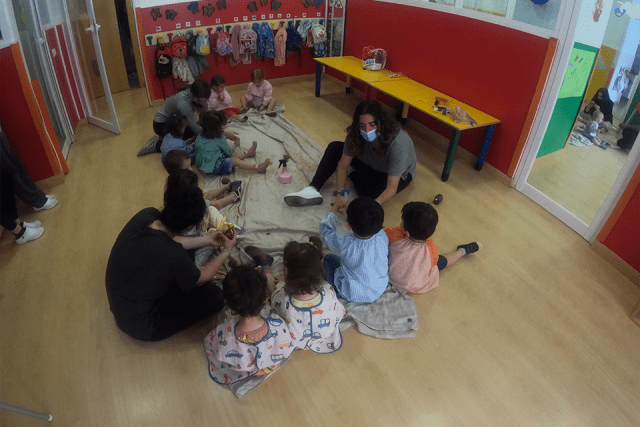
Students in the undergraduate Speech-Language Pathology program in St. John’s College of Liberal Arts and Sciences traveled to Salamanca, Spain, during the spring semester to participate in a clinical practicum as part of their Language Acquisition class. Taught by Max R. Freeman, Ph.D., CCC-SLP, Assistant Professor, Communication Sciences and Disorders, the class encompasses the phonological, syntactic, and cognitive aspects of language acquisition in childhood development.
“This trip was the first of its kind for the class, myself, and the department,” Dr. Freeman said. “Through this experiential practicum, our students gained an international perspective in their understanding of language development. This intercultural experience shall certainly inform their clinical training throughout their professional careers.”
The practicum, based on Dr. Freeman’s current research, used “Claynguage” to foster language acquisition in young children. “Claynguage”’ is the integration of clay in speech therapy, providing a tactile and kinesthetic learning environment for children. Students employed the “Claynguage” techniques and then evaluated the effectiveness of the method.
Dr. Freeman, with three student research assistants, began this project last year. The research group has been working with local preschool-aged children to assess the success of “claynguage,” and Dr. Freeman sought to incorporate a cross-cultural and experiential component in the practicum.
In collaboration with IES Abroad, students spent 10 days working at a day care center in Salamanca, applying the claynguage techniques in the classroom. Their goal was to integrate and enhance both Spanish and English language development in young children. The group donated the supplies, materials, and outlines to the day care center so that the teachers may continue to utilize claynguage in their classrooms.
Sara Kurutz, a research assistant, said the Salamanca trip offered the perfect balance of learning both inside and outside the classroom. “From the early morning to the early afternoon, we were at the day care center, working with the children using Claynguage techniques,” she said. “We finished by 1 p.m. and were able to explore the city of Salamanca and other parts of the country.”
However, with every great opportunity comes challenges. Sara noted that cultural and language barriers presented obstacles when working with the children.
“Many of us do not speak Spanish, and obviously for these children being natives of Spain, many of them do not speak English, or they are bilingual in other languages that are not English, so it was challenging at first to work with them,” she explained. “The children we worked with were between the ages of two to four. Many were experiencing language milestones such as first words, first sentences, etc., so it was a fantastic opportunity to expose them to English because they have a higher likelihood of retaining it.”
She continued, “We had to be creative in how we communicated with the children, and the clay and other physical learning styles helped us do that. Even though it was a challenge, I was able to see what we learned in the classroom before the trip come to life. I saw children learn language in real-time. Our curriculum is very applicable to real life.”
By the end of the trip, some of the children were able to remember and use the English words that they learned. “This experience helped students to develop critical thinking and problem-solving skills, while exposing them to new environments and cultures,” Dr. Freeman said.
Vaneiqua Wilson oversaw the undergraduate students and provided educational support. “This experience really taught me how to adapt,” she said. “Because of the language and cultural barriers, I found myself feeling stuck sometimes when students asked me for help. These children had different needs than the children we work with in Queens, and I really had to adapt to that.”
She credits her graduate coursework in the Speech-Language Pathology program for preparing her to assume this leadership role. “The coursework really gives you a solid foundation to understand language and language development.”
Related News
Dean Jerrold Ross Conference Room Unveiled
On Tuesday, December 10, the newly renovated conference room on the fifth floor of Sullivan Hall was dedicated in honor of Jerrold Ross, Ph.D., former Dean of The School of Education . The renovation...
Institute for Catholic Schools Provides Educational Resources to Local Catholic School
The Institute for Catholic Schools (ICS) in The School of Education at St. John’s University recently donated approximately $2,800 worth of academic and sensory learning tools to Father Vincent...
Meet Anna R. Lukachik ’80Ed, Pietas Medal Recipient
At St. John’s University’s annual Alumni Convocation on October 18, Anna R. Lukachik ’80Ed received the Pietas Medal, an award that honors exceptional alumni for their service and achievements...
